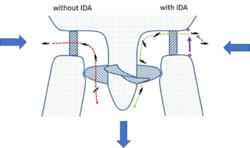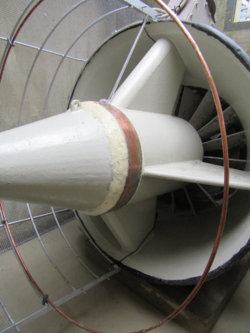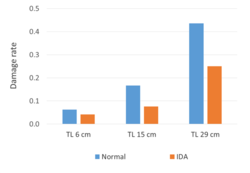Shaft hydropower plant
Contents
Quick summary
Date: 2020
Developed by: TU Munich, Chair of Hydraulic and Water Resources Engineering, Peter Rutschmann, Albert Sepp
Type: Device
Introduction
The HYDROSHAFT Powerplant is an innovative, fish-friendly hydropower concept, characterized by a horizontal rack, a submerged Kaplan turbine and a bypass for fish downstream migration immediately at the turbine intake. The hydropwer plant was originally developed to use existing non-gated weirs or ramps for hydropower generation. The HYDROSHAFT powerplant has a very simple geometry, doesn’t require a powerhouse and is therefore hardly visible or audible. It’s advantage for fish protection and ecology are the low velocities at the trash rack, the behavioral barrier through the horizontal fine-rack, the bypass for fish downstream migration and the possibility to pass all sediments over the shaft into the downstream.
Application
The HYDROSHAFT powerplant can use existing weirs or ramps but is also suitable to develop new hydropower at untouched rivers by the so-called multi-shaft concept. In the multi-shaft concept several shafts are combined with a so-called eco-migration corridor for fish and aquatic-sprecies migration. Due to its simple geometry the concept can be standardized and eventually prefabricate. Through the use of one or multiple shafts respectively the concept is scalable from small decentralized units up to large powerplants.
The powerplant has been extensively tested in the Lab of TU Munich in Obernach, where a 35kW pilot was built. Another equally sized pilot is situated at Voith Hydro in Heidenheim, Germany. The first larger powerplant is since February 2020 operational and feeds into the grid. It is located in Großweil, Bavaria, Germany at the Loisach River.
The HYDROSHAFT powerplant was tested in the Lab for its functionality, for the efficiency, for developing a suitable underwater trash-rack cleaner and for testing bypass migration routes and survival rates of fish. As a result of these investigations the following points are mentioned:
- The overall efficiency (measured at the clamp to theoretical) was measured 87%
- A completely new trash rack cleaner has been developed with MUHR HYDRO, Rosenheim, Germany
- The bypass into the downstream was used by most fishes and therefore overall mortality of the concept is very low
Due to the experimentally proven high survival rates the first plant at the Loisach River in a Natura 2000 reserve was possible. Also at the Iller River the highest German administrative court supported the granted water right without amendment. Whereas the first plant at the Loisach River was constructed in a very classical way the efforts are now intensified to lower costs by standardization. The next powerplant at the Iller River, Bavaria, Germany, will already economically work without subsidies. The final goal is to reach a price of about 5 Euro-Cents per KWh.
Relevant mitigation measures and test cases
| Relevant measures | |
|---|---|
| Fish-friendly turbines | |
| Relevant test cases | Applied in test case? |
| Altheim test case | - |
| Altusried test case | - |
| Anundsjö test case | - |
| Bannwil test case | - |
| Bragado test case | - |
| Gotein test case | - |
| Guma and Vadocondes test cases | - |
| Günz test case | - |
| Ham test case | - |
| Las Rives test case | - |
| Schiffmühle test case | - |
| Trois Villes test case | - |
Other information
TUM holds an EU patent for the IDA (EP3029203).
Relevant literature
FIThydro deliverable D3.4 available at https://www.fithydro.eu/deliverables-tech/


